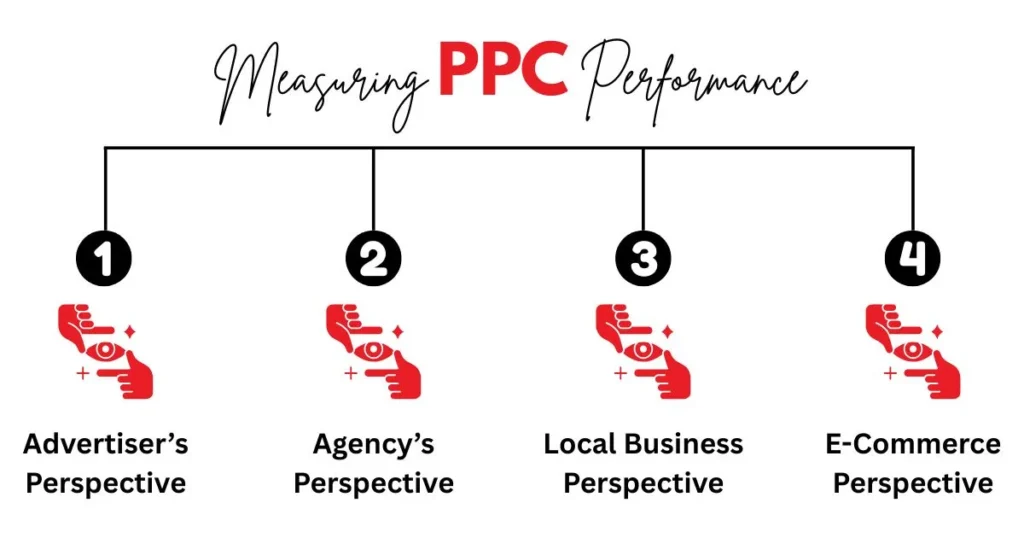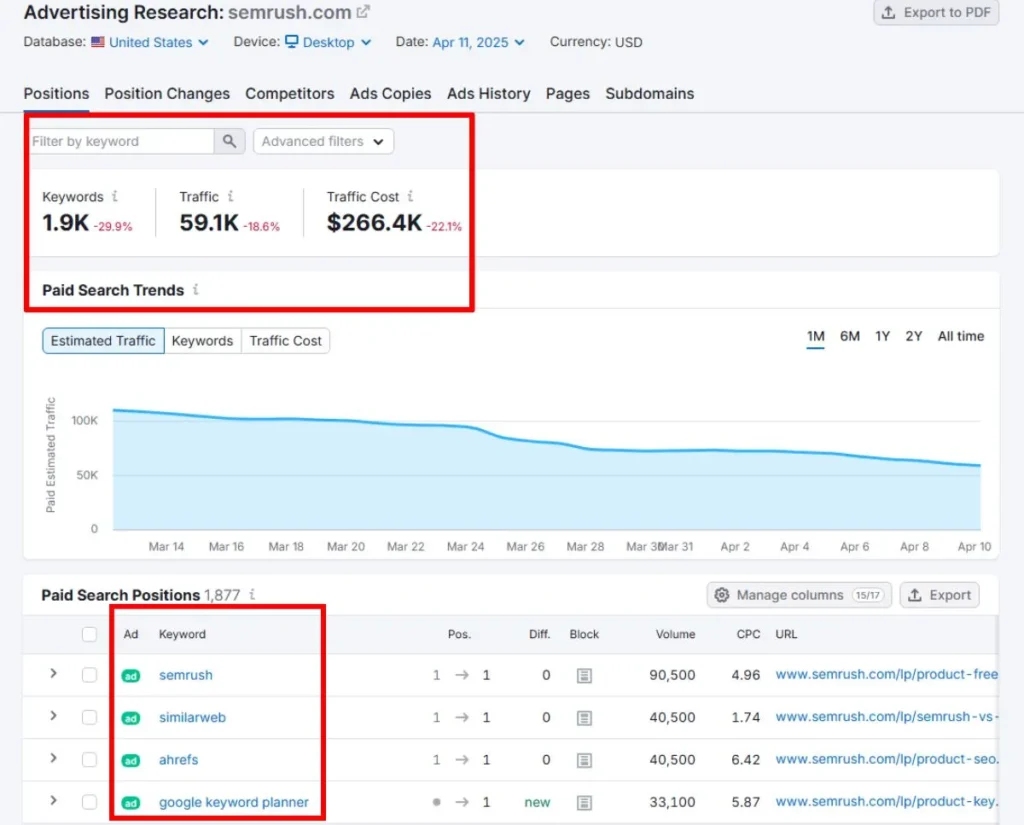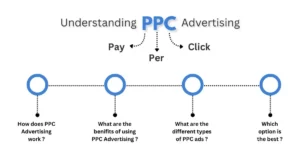
Pay-per-click (PPC) advertising is a powerful tool for businesses looking to grow their online presence, but its success is not just about setting up ads and hoping for the best. Optimizing PPC is essential to unlock the full potential of your PPC efforts. You need to measure PPC performance, understand key metrics, and continuously refine your approach. Whether you’re new to PPC or a seasoned marketer, this guide will provide you with a solid foundation for assessing the effectiveness of your campaigns and driving a strong return on investment (ROI).
Table of Content
- 1 The Key Metrics for PPC Success
- 2 Using Google Analytics to Track PPC Results
- 3 Understanding Conversion Tracking in PPC
- 4
- 5 How to Calculate Cost Per Acquisition (CPA)?
- 6 Understanding ROI’s Importance in PPC Campaign Evaluation
- 7 Tools for PPC Reporting and Analytics
- 8 Optimizing Underperforming PPC Ads
- 9 Measuring the Lifetime Value of PPC Customers
- 10 The Impact of PPC on Brand Awareness
- 11 Case Studies: Analyzing Real-World PPC Data
- 12 Conclusion
The Key Metrics for PPC Success
The success evaluation of PPC campaigns requires identifying the correct metrics for measurement. You should concentrate on these vital metrics, which are essential for your PPC success evaluation:
Click-Through Rate (CTR)
The Click-Through Rate (CTR) serves as a top metric that advertisers must evaluate within their PPC campaigns. CTR tracks the relationship between click counts and advertisement exposure to show how effectively ads attract possible buyers.
Cost Per Click (CPC)
The average expense for clicks on your advertisement determines the Cost Per Click (CPC) measurement. Your budgeting needs and lead expenditure analysis depend on Cost Per Click because it serves as an essential spending measurement.

More budgetary efficiency occurs when your CPC decreases because it allows you to obtain more clicks from your advertising spend.
Conversion Rate
The portion of users who perform a specified action following an ad click defines the Conversion Rate. The direct quantitative measure of advertising effectiveness appears as the conversion rate.

A high conversion rate implies that the landing page delivers what ads promise to customers while maintaining a satisfactory user experience.
Return on Investment (ROI)
Your PPC campaign’s profitability is assessed through the important metric called Return on Investment (ROI). The metric measures revenue achieved through the campaign against actual ad expenses.

Your campaign generates profits exceeding costs when showing positive ROI, but you must rethink the approach when ROI becomes negative.
Using Google Analytics to Track PPC Results
Optimizing PPC performance metrics of your PPC campaigns can be tracked effectively by utilizing Google Analytics as a tool. Your Google Ads performance improves when you connect it to Google Analytics because this gives you complete data about user website behaviour post-ad clicks.
Key Metrics in Google Analytics:
- Sessions: PPC ads generate a complete count of visitor sessions to the website.
- Goal Completions: The tracker monitors designated activities, together with purchases or account creation.
- Bounce Rate: The measurement shows the number of visitors who abandoned your website after inspecting a single page.
- Pages per Session: The system determines user engagement by counting the total number of pages visitors view while browsing the website.
The review of these metrics found in Google Analytics enables you to track PPC traffic performance for informed campaign optimization.
Understanding Conversion Tracking in PPC
Any PPC campaign needs conversion tracking to serve as its most essential component. You cannot determine your ads’ success through desired results because proper conversion tracking is not in place.
How Conversion Tracking Works?
The conversion tracking tools, including Google Ads conversion tracking, help users establish tracking codes that operate on their websites. Your PPC platform receives tracking data whenever a user accomplishes one of the defined conversion actions on your website, including form submissions or purchases.
Benefits of Conversion Tracking:
- Optimised bidding: Your bidding strategy becomes more accurate through conversion tracking since it generates data about keyword and ad performance.
- ROI measurement: The system allows you to assign conversions to individual campaigns, which streamlines ROI calculation.
- Better targeting: A complete set of conversion data enables you to represent your content better to appropriate target groups.
How to Calculate Cost Per Acquisition (CPA)?
Optimizing PPC campaigns involves an evaluation of profitability from Cost Per Acquisition (CPA) as one of the key performance indicators. CPA refers to the total expense needed to gain either new customers or leads through PPC advertising.

Your PPC campaign demonstrates efficiency in conversion generation when the CPA remains low, but it signals optimization needs when the CPA reaches high levels.
Understanding ROI’s Importance in PPC Campaign Evaluation
Optimizing PPC campaigns requires careful evaluation demands ROI because it represents the most vital metric for determining sustained campaign success. The analysis of ROI provides details about whether your advertisement budget delivers revenue or requires modification of your strategy.
The following strategies should be used to enhance ROI:
- Refine your targeting: Your advertising effort must connect with the target customer base.
- Optimize your ads and landing pages: Optimized landing pages & High-Quality ads can maximize conversion rates and reduce CPA.
- Test and iterate: Ongoing experiments with various advertisement variations will identify which one generates the best outcomes.
Tools for PPC Reporting and Analytics
Various applications exist to aid your evaluation and assessment of how well your PPC campaigns perform. A list of popular tools exists for PPC reporting and analytics.
Google Ads Reports
Through its reporting tools, Google Ads presents users with dynamic metrics analysis, which enables tracking of CTR, CPC, conversions and ROI details. You obtain specialized reports in Google Ads that highlight certain aspects of your promotional initiative.
SEMrush
SEMrush contains advanced & Optimized PPC analysis capabilities that let users examine rival advertising approaches and track keyword metrics as well as observe their PPC expenditure.

WordStream
WordStream offers exceptional PPC management software that helps users improve their advertising campaigns. The dashboard of this platform tracks multiple performance metrics, providing optimization suggestions based on them.
Kissmetrics
The monitoring and evaluation of long-term conversions and customer behaviour make Kissmetrics an excellent analytical instrument. The system shows complete customer paths extending beyond the initial website click.
Optimizing Underperforming PPC Ads
All PPC campaigns include underperforming ads despite their initial quality standards. The news becomes positive regarding the underperformance of PPC ads since they tend to show improvement after optimization. Here’s how:
Improve Ad Copy
Your advertising messages must be interesting and specifically designed to reach your target audience. Your ad content must focus on advantages instead of features while including a strong action request.
Refine Targeting
A targeting problem could exist if your ads receive insufficient click-throughs or conversion activities. You should specify your audience by their demographic data in combination with geographic areas and specific preferences.
Test Ad Variations
Test two different advertisement versions to determine their performance levels through A/B testing. A/B testing allows you to identify the most efficient design, together with message structure.
Measuring the Lifetime Value of PPC Customers
The sum of revenue that customers will produce throughout their entire association with your business defines Lifetime Value (LTV). The analysis of LTV within PPC procedures enables better insights into the extended value of customers gained from ads.
How to Calculate LTV?
The calculation of LTV involves multiplication between the average purchase value average number of purchases, and the average customer lifespan.

The long-term revenue a customer generates enables you to judge if your CPA is appropriate thus, LTV serves as a vital measure for PPC campaign performance assessment.
The Impact of PPC on Brand Awareness
PPC plays its main role in conversion generation, but simultaneously functions to create brand recognition in the marketplace. Your brand expands market visibility through strategic advertising, which helps you draw new customers who subsequently enhance total market recognition.
Strategies for Leveraging PPC for Brand Awareness:
- Use display ads: Display ads successfully maintain brand visibility for potential customers, while they do not need to immediately click on offers.
- Retargeting: Targeted ads through retargeting maintain your brand at the forefront of users who have already had contact with your company.
- Focused messaging: All marketing advertisements should reflect your brand characteristics and Messaging so customers receive a cohesive customer experience between platforms.
Case Studies: Analyzing Real-World PPC Data
PPC metrics, along with their practical applications, receive clear representation through case studies as effective examples. Here are two actual examples to illustrate the point:
Case Study 1: E-Commerce Store
A targeted PPC campaign with high-converting keywords was run for an e-commerce store. Although the decrease in CPA was 30% and the increase in conversion rate was 15% by continuously optimizing their ads and website landing pages.
Case Study 2: Local Service Provider
PPC was an effective tool for a local service provider to raise brand awareness among their target audience. Their strategy increased local search traffic by 40% and inquiries by 20% when focusing on a combination of search and display ads.
Conclusion
Optimizing PPC performance is not just about tracking the basics, i.e., clicks & impressions. You’ll want to dig much deeper into conversion tracking, CPA, ROI, & customer lifetime value to really optimize your campaigns. With the right tools, optimization of your ads, and proper measurement of ROI, you can make sure your PPC campaigns generate meaningful business results.
On a final note, PPC is an ever-evolving landscape and it is crucial to regularly iterate upon everything you do. You can adjust your strategy in order to stay competitive and maximize the return on investment (ROI) from your advertising spend.
Featured Blogs

PPC Campaigns: Effective Strategies for Successful PPC Advertising
Businesses use Pay-Per-Click (PPC) advertising to directly reach their target audience, which they can measure through this method. Establishing successful...

PPC Guide: Everything You Must Know
Pay-per-click (PPC) advertising proves itself as the top approach within digital marketing to deliver precise traffic while simultaneously boosting brand...
Faran Bilal
Faran Bilal is a results-driven PPC and email marketing expert with a passion for helping businesses maximize ROI, generate high-quality leads, and drive conversions. With years of experience in Google Ads, Facebook Ads, and data-driven email campaigns, Faran excels in crafting targeted strategies that deliver measurable results. As a contributor to DigiPro, Faran shares expert insights, proven tactics, and in-depth guides on paid advertising, audience targeting, and email automation. Whether it's optimizing ad campaigns for better performance or designing high-converting email sequences, Faran is committed to empowering businesses with actionable marketing strategies. 📢 Follow Faran Bilal for the latest PPC & email marketing trends!
 Limited Spots Available! Apply Now!
Limited Spots Available! Apply Now!  Experience top-quality learning before you commit!
Experience top-quality learning before you commit!
Links will be automatically removed from comments.